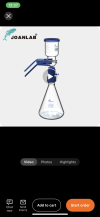El Tiburon
New Member
I'm making my first test e homebrew and I have a few questions
1) What size bottle top filter should I use and vacuum pump
2)How do I transfer the filtered oil into a OPEN vial as sterile as possible?
Your advices would be appreciated.
1) What size bottle top filter should I use and vacuum pump
2)How do I transfer the filtered oil into a OPEN vial as sterile as possible?
Your advices would be appreciated.


